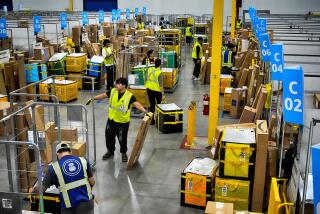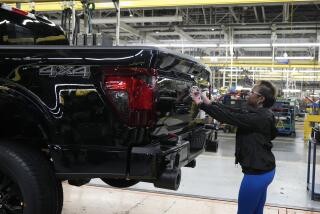economy
WASHINGTON -- â Productivity surged from April through June, posting the largest gains in almost six years, as businesses slashed hours faster than output fell, according to government data released Tuesday.
The Labor Department said productivity -- output per hour of all individuals -- in the nonfarm business sector increased in the second quarter at a seasonally adjusted annual rate of 6.4%, following a pace of 0.3% during the first three months of the year.
The gain was the largest since the third quarter of 2003, and it pushed productivity rates well above the average annual rate of 2.5% from 2000 through 2008, the report noted.
Rising productivity bodes well for corporate profit margins, analysts said. And major companies such as Starbucks Corp. and Google Inc. recently reported profit gains even as revenue declined due to cost-cutting. Analysts disagree, however, on whether increased productivity bodes equally well for the more than 14 million out-of-work Americans, especially the almost 5 million who have been unemployed for 27 weeks or longer.
Some argue that businesses will learn to do more with fewer people, giving them less reason to hire and making it more likely that the recession will be followed by a jobless recovery, in which the economy grows but employment lags behind. Others say a rebound in corporate profits will boost business investment and, eventually, employment.
âThe fact that American workers are capable of generating these amazing productivity gains ultimately is good news for employment. As the economy moves from recovery in the second half of 2009 and the first half of 2010, to potential expansion in the second half of 2010 and beyond, there is no doubt that businesses will have a strong desire to add more of these high-quality workers into their teams,â Brian Bethune, chief U.S. financial economist for IHS Global Insight, said Tuesday in a note to clients.
The productivity report showed nonfarm business output declined more slowly in the second quarter, at an annual rate of 1.7%, than did hours worked, which fell at a rate of 7.6%. But compared with the same period last year, output fell at an annual rate of 5.6% and hours worked fell at a rate of 7.3%.
Labor costs also decreased significantly. Unit labor costs, which measure the cost of compensation and benefits per unit of manufactured output, fell at a rate of 5.8% -- more than twice the first quarterâs rate.
Hourly compensation edged up at a rate of 0.2% after falling at a pace of 2.4% in the first quarter. This was before a mandated increase in the minimum wage in July to $7.25 per hour. Real hourly compensation, however, declined at a rate of 1.1% due mainly to rising gasoline prices.
In the manufacturing sector, output for the second quarter decreased at a rate of 15% compared with the same period last year, and hours worked fell at a pace of 13.9%. Output of durable goods -- autos, appliances and other items built to last at least three years -- declined at a rate of 21.1% compared with the second quarter of 2008, while hours worked in that sector fell at a rate of 16.9%.
A separate report released by the Commerce Department on Tuesday said that wholesalers slashed inventories more than expected in June and that sales rose for the second consecutive month, albeit by a modest 0.4%. The faster businesses can shed unsold goods, the more quickly they will have to start ordering again.
More to Read
Inside the business of entertainment
The Wide Shot brings you news, analysis and insights on everything from streaming wars to production â and what it all means for the future.
You may occasionally receive promotional content from the Los Angeles Times.










